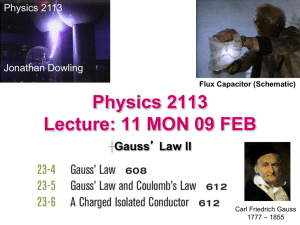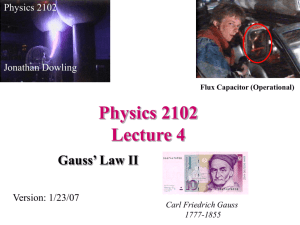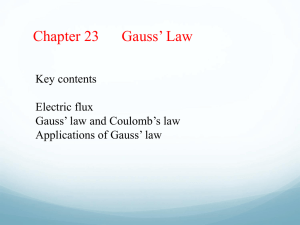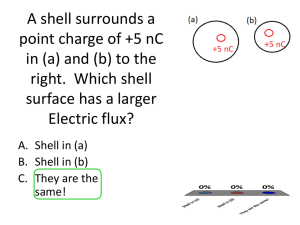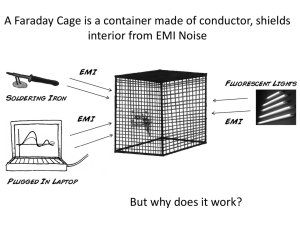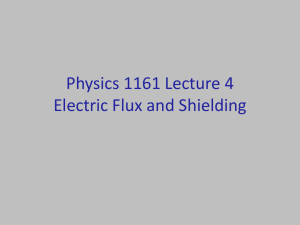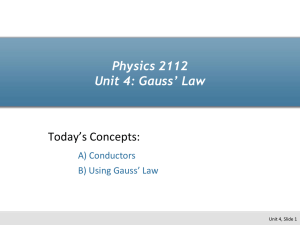PowerPoint
advertisement
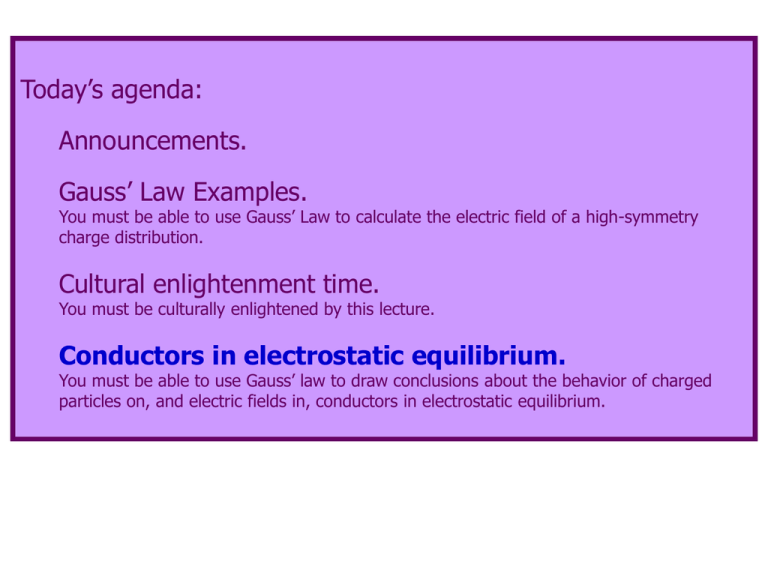
Today’s agenda: Announcements. Gauss’ Law Examples. You must be able to use Gauss’ Law to calculate the electric field of a high-symmetry charge distribution. Cultural enlightenment time. You must be culturally enlightened by this lecture. Conductors in electrostatic equilibrium. You must be able to use Gauss’ law to draw conclusions about the behavior of charged particles on, and electric fields in, conductors in electrostatic equilibrium. Conductors in Electrostatic Equilibrium Homework hints buried in the next 3 slides! Electrostatic equilibrium means there is no net motion of tne charges inside the conductor. The electric field inside the conductor must be zero. If this were not the case, charges would accelerate. Any excess charge must reside on the outside surface of the conductor. Apply Gauss’ law to a Gaussian surface just inside the conductor surface. The electric field is zero, so the net charge inside the Gaussian surface is zero. Any excess charge must go outside the Gaussian surface, and on the conductor surface. The electric field just outside a charged conductor must be perpendicular to the conductor’s surface. Otherwise, the component of the electric field parallel to the surface would cause charges to accelerate. The magnitude of the electric field just outside a charged conductor is equal to /0, where is the magnitude of the local surface charge density. A simple application Gauss’ Law. Different from infinite sheet of charge because E is zero inside the conductor. If there is an empty nonconducting cavity inside the conductor, Gauss’ Law tells us there is no net charge on the interior surface of the conductor. Construct a Gaussian surface that includes the inner surface of the conductor. The electric field at the Gaussian surface is zero, so no electric flux passes through the Gaussian surface. Gauss’ Law says the charge inside must be zero. Any excess charge must lie on the outer surface! The conductor does not have to be symmetric, as shown. If there is a nonconducting cavity inside the conductor, with a charge inside the cavity, Gauss’ Law tells us there is an equal and opposite induced charge on the interior surface of the conductor. Construct a Gaussian surface that includes the inner surface of the conductor. The electric field at the Gaussian surface is zero, so no electric flux passes through the Gaussian surface. Gauss’ Law says the charge inside must be zero. There must be a –Q on the inner surface. If the net charge on the conductor is not –Q, any additional charge must lie on the outer surface! The conductor does not have to be symmetric. +Q -Q Example: a conducting spherical shell of inner radius a and outer radius b with a net charge -Q is centered on point charge +2Q. Use Gauss’s law to show that there is a charge of -2Q on the inner surface of the shell, and a charge of +Q on the outer surface of the shell. q enclosed E dA ε 0 -Q r a E=0 inside the conductor! +2Q b QI Let r be infinitesimally greater than a. q enclosed QI 2Q 0 QI -2Q ε0 ε0 Example: a conducting spherical shell of inner radius a and outer radius b with a net charge -Q is centered on point charge +2Q. Use Gauss’s law to show that there is a charge of -2Q on the inner surface of the shell, and a charge of +Q on the outer surface of the shell. QI -2Q -Q r From Gauss’ Law we know that excess* charge on a conductor lies on surfaces. a +2Q b QI Electric charge is conserved: Qshell -Q QI QO -2Q QO QO - Q -2Q QO QO Q *excess=not required to give E=0 inside the conductor Example: an insulating sphere of radius a has a uniform charge density ρ and a total positive charge Q. Calculate the electric field at a point inside the sphere r a q enclosed E dA o Q This object in this example is not a conductor. See Dr. Waddill’s lecture on Gauss’ Law from a few years ago. Click on the word “lecture” in the previous sentence to view/download the lecture. Here is the address for you to copy and paste into a web browser, in case the link in the above paragraph doesn’t work: http://campus.mst.edu/physics/courses/24/Handouts/Lec_03.ppt Demo: Professor Tries to Avoid Debilitating Electrical Shock While Demonstrating Van de Graaff Generator http://en.wikipedia.org/wiki/Van_de_Graaff_generator

